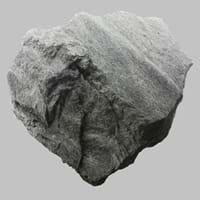Definition
Phyllite is a fine-grained metamorphic rock with a well-developed laminar structure, and is intermediate between slate and schist rocks
Obsidian is a naturally occurring volcanic glass formed as an extrusive igneous rock. It is produced when felsic lava extruded from a volcano cools rapidly with minimum crystal growth
Discoverer
Unknown
Obsius
Etymology
From Greek phullon leaf + -ite1
From Latin obsidianus, misprint of Obsianus (lapis) (stone) of Obsius
Class
Metamorphic Rocks
Igneous Rocks
Sub-Class
Durable Rock, Soft Rock
Durable Rock, Medium Hardness Rock
Group
Not Applicable
Volcanic
Other Categories
Coarse Grained Rock, Fine Grained Rock, Medium Grained Rock, Opaque Rock
Opaque Rock
Texture
Phyllitic Sheen, Slaty
Glassy
Color
Black to Grey, Light Greenish Grey
Black, Blue, Brown, Green, Orange, Red, Tan, Yellow
Durability
Durable
Durable
Appearance
Crinkled or Wavy
Shiny
Interior Uses
Decorative Aggregates, Floor Tiles, Homes, Interior Decoration
Decorative Aggregates, Interior Decoration
Exterior Uses
As Building Stone, As Facing Stone, Garden Decoration
Garden Decoration
Other Architectural Uses
Curbing
Not Yet Used
Construction Industry
As Dimension Stone, Building houses or walls, Cement Manufacture, Construction Aggregate, for Road Aggregate, Raw material for the manufacture of mortar, Roadstone
Arrowheads, Cutting Tool, Knives, Scrapers, Spear Points
Medical Industry
Not Yet Used
Surgery
Antiquity Uses
Artifacts, Sculpture
Artifacts, Jewellery
Commercial Uses
Cemetery Markers, Commemorative Tablets, Creating Artwork, Writing Slates
Creating Artwork, Mirror, Used in aquariums
Types
Not Available
Fireworks Obsidian, Mahogany, Sheen Obsidian, Snowflake obsidian and Velvet Peacock Obsidian
Features
Easily splits into thin plates, Is one of the oldest rock, Surfaces are often shiny
Blocks negativity, Helps to protect against depression
Archaeological Significance
Monuments
Not Yet Used
Not Yet Used
Famous Monuments
Not Applicable
Not Applicable
Sculpture
Used
Not Yet Used
Famous Sculptures
Data Not Available
Not Applicable
Figurines
Used
Not Yet Used
Formation
Phyllite is a metamorphic rock which is formed by regional metamorphism of argillaceous sediments since their cleavage arose due to deviatoric stress.
When the lava is released from volcano, it undergoes a very rapid cooling which freezes the mechanisms of crystallization. The result is a volcanic glass with a uniform smooth texture.
Mineral Content
Albite, Alusite, Amphibole, Apatite, Biotite, Chlorite, Epidote, Feldspar, Garnet, Graphite, Hornblade, Kyanite, Micas, Muscovite or Illite, Porphyroblasts, Quartz, Sillimanite, Staurolite, Talc, Zircon
Not Available
Compound Content
CaO, Carbon Dioxide, MgO
Aluminium Oxide, CaO, Iron(III) Oxide, FeO, Potassium Oxide, MgO, MnO, Sodium Oxide, Phosphorus Pentoxide, Silicon Dioxide, Titanium Dioxide
Types of Metamorphism
Not Applicable
Burial Metamorphism, Cataclastic Metamorphism, Contact Metamorphism
Types of Weathering
Biological Weathering, Chemical Weathering, Mechanical Weathering
Biological Weathering, Chemical Weathering, Mechanical Weathering
Types of Erosion
Chemical Erosion, Coastal Erosion, Glacier Erosion, Water Erosion, Wind Erosion
Chemical Erosion, Coastal Erosion, Glacier Erosion
Grain Size
Medium to Fine Coarse Grained
Not Applicable
Fracture
Conchoidal
Conchoidal
Porosity
Highly Porous
Very Less Porous
Luster
Phyllitic
Vitreous
Compressive Strength
Not Available
Cleavage
Crenulation and Pervasive
Non-Existent
Toughness
1.2
Not Available
Specific Gravity
2.72-2.73
2.6-2.7
Transparency
Opaque
Translucent
Density
2.18-3.3 g/cm3
2.6 g/cm3
Specific Heat Capacity
Not Available
Resistance
Heat Resistant, Pressure Resistant, Water Resistant
Heat Resistant, Impact Resistant
Deposits in Eastern Continents
Asia
Afghanistan, Bangladesh, Bhutan, China, India, Japan, Kazakhstan, Malaysia, Pakistan, Russia, Thailand, Turkey, Vietnam
Afghanistan, Indonesia, Japan, Russia
Africa
Egypt, Ethiopia, Morocco, Nigeria, South Africa
Kenya
Europe
Austria, England, France, Georgia, Germany, Italy, Liechtenstein, Monaco, Norway, Slovenia, Spain, Sweden, Switzerland
Greece, Hungary, Iceland, Italy, Turkey
Others
Not Yet Found
Not Yet Found
Deposits in Western Continents
North America
Canada, Costa Rica, Cuba, Mexico, Panama, USA
Canada, Mexico, USA
South America
Brazil, Colombia, Guyana
Argentina, Chile, Ecuador, Peru
Deposits in Oceania Continent
Australia
New South Wales, New Zealand, Queensland
New Zealand










